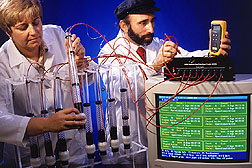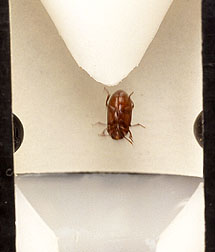EGPIC: An Automated Insect Census-Taker
Stored grains, fruits, nuts, vegetables, and other foods are a smorgasbord for rice weevils, sawtoothed grain beetles, and other insects that feast on stored products. Insect infestations cause millions of dollars in annual stored product losses and fumigation costs.
But the free lunch for these pests may soon be over. Scientists at ARS' Center for Medical, Agricultural, and Veterinary Entomology (CMAVE) in Gainesville, Florida, have developed a high-tech system that exposes the gluttonous meal robbers.
The new pest detector, developed by electrical engineer Dennis Shuman, is called the Electronic Grain Probe Insect Counter, or EGPIC.
"Low insect populations are difficult to detect in small samples, so a much greater proportion of the grain needs to be sampled to accurately estimate the size of an insect population," he says.
A probe trap is a perforated tube inserted into grain that insects crawl into and then drop through into a reservoir at the lower end. Presently, probes are left in grain bins for prolonged periods, until an inspector manually removes and visually inspects them--a time-consuming and sometimes difficult procedure.
"These methods are expensive, so they are not repeated often. This allows infestations to grow from undetectable to damaging levels in a matter of weeks," says Shuman.
EGPIC is an enhancement of current grain probe trap technology. It uses an infrared beam sensor to quickly, accurately, and economically record and time-stamp insects as they drop through the probe.
Shuman says the probes can be located throughout a grain bin or elevator. Their sensors can transmit insect counts back to a central computer via SMARTS, a data transmission network Shuman designed and patented for large-scale monitoring.
While current methods give only a snapshot of what's going on, EGPIC provides a continuous moving picture of what's happening inside a storage bin--and an accurate picture, having a 95 percent counting accuracy rate in lab tests.
Best of All, It's Flexible
Shuman's version has an adaptable design and can be customized, depending on the type of stored product and storage environment. Environmental factors such as temperature, humidity, noise and vibration, dust, and chemical pesticides won't throw off its results.
Current traps require routine maintenance and have a finite life, since they fill up with insects and have to be emptied or removed. To reduce this maintenance, Shuman is working on a version that has a long, open-ended tube below the sensor so insects can be counted and released lower in the bin--virtually eliminating the need for trap servicing.
Monitoring stored-product insects is important mainly for two reasons: Insect infestations can cause high damage and losses if left unchecked, and they require costly chemical fumigation.
EGPIC allows companies to avoid or reduce insecticides. "General practice has been to make scheduled pesticide treatments--independent of knowing how big the problem is," says Shuman.
By accurately estimating the distribution of an insect population, companies may not have to treat the entire bin. The new system allows them to target treatments by knowing what is going on at any given moment.
This is a big advantage, considering the proposed worldwide ban on methyl bromide, a widely used, highly effective fumigant used for stored product insect control. The United States, in accordance with the U.S. Environmental Protection Agency's Clean Air Act, plans a phaseout of methyl bromide by the year 2001.
Currently, there is no single replacement for it. Companies will ultimately have to use a combination of treatments, which could increase the cost of fumigating. Pinpointing infestations and knowing their severity will allow companies to better plan their fumigation strategies.
More EGPIC benefits:
- It requires minimal maintenance at sensing sites to permit monitoring at hard-to-reach locations.
- It's capable of sensing all different stored product insect pest species at low densities.
- It's compatible with other grain management systems.
- It can be used without extensive training.
Shuman says EGPIC is ready for commercialization.
Eight copies of the prototype EGPIC system are being evaluated in lab and field tests with different products, climates, and locations.
"We want to see if different conditions affect the system and, if necessary, adapt the system to meet those conditions," says Shuman. "Research with this new tool may also reveal new approaches to monitoring pest population dynamics."
Entomologists Nancy D. Epsky and Richard T. Arbogast are each testing one of the copies. "The biggest problem with traps is relating trap catch to the population density," says Epsky, who works at CMAVE.
Epsky is evaluating the system's performance for detecting a broad range of insects. "I'm going to look at insect
density and species and how they will affect the system. We're trying to take all possible situations and determine if they have an impact on count accuracy," she says.
For instance, Epsky thinks insect behavior may affect the trap count. She says certain insects are more "grabby" and thus more likely to fall down in pairs and to be counted as one insect.
Also, insect shape and size play a role and affect the size of a sensor's output signal. "By analyzing this information and compiling guidelines, the EGPIC system can be configured to discriminate between different insect species based on their size," Epsky says. "We're hoping to fine-tune the system, so we can more precisely determine what species is infesting the grain."
Trap catch is also related to temperature and other characteristics of the insect's environment, such as grain moisture content and the amount of open space between grain kernels, says Arbogast, who is also based at CMAVE.
"These relationships must be defined, to maximize the value of EGPIC for monitoring insect infestations in actual storage situations," he says. Recognizing this, Shuman has incorporated automated temperature and humidity monitoring into the overall system design.
Among other sites testing the prototypes are Agricultural Research Service labs in Manhattan, Kansas, and Fresno, California, along with researchers at Oklahoma State University in Stillwater and at Montana State University in Bozeman.
A modified version of EGPIC called BICAP (Beneficial Insect Counting and Packaging Device, patented) uses an EGPIC sensor head and cups on a computer-controlled turntable to count and package mass-reared beneficial insects more efficiently than by hand. Walt Disney World's EPCOT Center at Orlando, Florida, has been using the system to count and package Opius dissitus, a parasitic wasp reared in their laboratory as a biological control for leafminer pests in gardens throughout Disney World.
"EGPIC is one step towards high-tech monitoring. Our focus continues to be on innovative sensing methods for detecting insect infestations in and around stored products," says Shuman.--By Tara Weaver, Agricultural Research Service Information Staff.
Dennis Shuman, Nancy D. Epsky, and Richard T. Arbogast are with the USDA-ARS Center for Medical, Agricultural, and Veterinary Entomology, 1700 SW 23rd Dr., Gainesville, FL 32604; fax (352) 374-5781.
[Shuman] phone (352) 374-5737.
[Epsky] phone (352) 374-5761.
[Arbogast] phone (352) 374-5719.
"EGPIC: An Automated Insect Census-Taker" was published in the September 1998 issue of Agricultural Research magazine. Click here to see this issue's table of contents.








